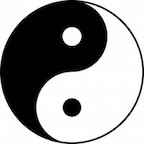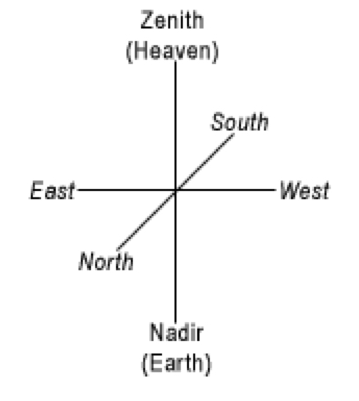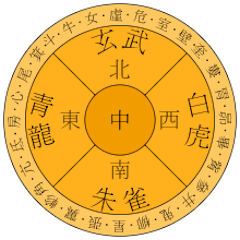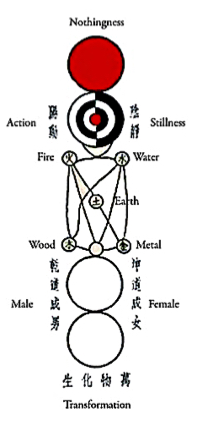The Chinese cosmological construct is based on the observed cyclical
movements of the heavens. Diagrammatically, north is the zenith and
earth is the nadir.
The area between
the two poles is divided into 28 mansions (Chinese:二十八宿) −−7
mansions per quadrants.
Each quadrant with its 7 mansions is ruled by a cosmic animal: the
Azure Dragon in the east, the Vermillion Bird in the south, the White
Tiger in the west, and the Black Turtle in the North. Everything on
earth can be explained by the movements of heaven. A fifth cosmic
animal, the Yellow Dragon situated on the origin, rules all. When
the ruler of China claims he has the the mandate of heaven, he is
saying he is under the protection of the Yellow Dragon.
Lao Tzu (601) described the generation of all things in the universe
in the Tao Te Ching:
| |
The
Tao begot one.
One begot two.
Two begot three.
And three begot the ten thousand things. [1] |
Later, Zhou Dunyi (1017-1073), a neo-Confucianist, further explained
the cosmic forces:
| |
The
Supreme Polarity in activity generates yang; yet at the limit
of activity it is still. In stillness it generates yin; yet
at the limit of stillness it is also active. Activity and stillness
alternate; each is the basis of the other. In distinguishing
yin and yang, the Two Modes are thereby established. The alternation
and combination of yang and yin generate water, fire, wood,
metal, and earth. With these five [phases of] qi harmoniously
arranged, the Four Seasons proceed through them. [2] |
Whether Zhou Dunyi abstracted the diagram taijitu* (太極圖,
太極図) from Daoist sources or not, it demonstrates Lao Tzu's
explanation of how everything came to be in the universe.
| 1. |
The
red circle at the top depicts the absolute (Wuji), which is
sometimes referred to as emptiness or void. |
| 2. |
The
second circle represents the Taiji, the dual forces of yin and
yang. |
| 3. |
Below
the second circle is a five-part diagram representing the Five
Agents (Wuxing), the further stage of differentiation of Unity
into Multiplicity. |
| 4. |
The
circle below the Five Agents represents the conjunction of Heaven
and Earth, which in turn gives rise to the "ten thousand
things". |
| 5. |
The
final circle represents the state of multiplicity, in which
the ten thousand things are born by transformation. |
The Book of
Changes, the I Ching, is based on the Taiji, the "two,"
the dual forces yin and yang. The Taiji movement generates Five
energetic forces, Wu Xing (五行):
Wood (木), Fire (火),
Earth (土), Metal (金),
Water (水). They represent the dynamic,
interdependent aspects of the universe’s ongoing existence and
development. They explain the movement, the alteration, the changing
states, the permutations, and the metamorphoses of the universe.
They have identifiable correlations in the natural processes on
earth. For example:
| 1. |
Water
(水) is associated with the potential
of new life hidden in the dark ground beneath the snows of winter. |
| 2. |
Wood
(木) is associated with the exuberance
of new growth as it shoots up from the earth in the spring.
|
| 3. |
Fire
(火) is associated with the process
of maturation that takes place under the warmth of the summer
sun. |
| 4. |
Earth
(土) is associated with ripening
of grains in the yellow fields of late summer. |
| 5. |
Metal
(金) is associated with the harvest
of autumn and the storage of seed for next year's planting and
a new cycle. |
Wu Xing is
the paradigmatic basis for other systems.
| Agent |
Direction |
Season |
Human
Body |
Cosmic
Animal |
| Wood |
East |
Spring |
Liver,
Gallbladder |
Azure
Dragon |
| Fire |
South |
Summer |
Heart,
Small Intestine |
Vermillion
Bird |
| Earth |
Center |
Indian
Summer |
Stomach,
Spleen |
Yellow
Dragon |
| Metal |
West |
Autumn |
Lungs,
Large Intestine |
White
Tiger |
| Water |
North |
Winter |
Kidneys,
Bladder |
Black
Turtle |
In accordance with the Wu Xing schema, the cyclical progression of
the seasons is aligned with the 4 quadrants of the heavens. The 5th
elemental phase, Earth, is generally ignored, as it represents the
origin which is "unmoving."
This series, "The Four Seasons" consist of a 4-paneled painting
for each season entitled:
| |
Spring:
Movement in Stillness, Stillness in Movement
(静かなる池畔,静と動) |
| |
Summer:
Just Be (現時点) |
| |
Autumn:
Return to Earth (土を戻る) |
| |
Winter:
Greeting the Winter Sun (陽の喜び) |
 |
"Spring" (静かなる池畔,静と動)
reflects the Taiji symbol. The cherry tree, turtles and pine tree
are in Yin mode; their reflections are like the tail of the white
paisley shape, symbolizing the incipience of Yang. The swimming
carp are Yang. The egret with its cocked head is at supreme stillness.
Any moment it will explode into movement as it snatches something
in the water.
"Summer" is an invitation for the viewer to imagine himself
standing at the promontory point, with the vast expanse of earth
and sky before him. Practitioners of meditation are asked to let
go of thoughts of the past and plans for the future, to concentrate
on the breath and "just be" (現時点).This
painting invites the viewer to be like the pine tree and the Stellar's
sea eagle; let the mind join the vastness of space.
"Autumn" is the downturn of the seasonal cycle when things
"return to earth" (土を戻る).The
outward progression of emerging life in Spring, and the energetic
expansion of yang qi in Summer, begins to turn into an inward progression
of yin as suggested by the tail of the black paisley shape in the
Taiji symbol.
"Winter" is regeneration. The red-crowned cranes joyfully
"greeting the winter sun" (陽の喜び)
signify the return of Yang, warmth and new life.
Notes:
| [1] |
Verse 42
translated by Gia-Fu Feng and Jane English
Wildwood House 1991, first published 1972 |
| [2] |
Adler,
Joseph A. (1999)
"Zhou Dunyi: The Metaphysics and Practice of Sagehood",
in Sources of Chinese Tradition,
William Theodore De Bary and Irene Bloom, editors, 2nd ed.,
2 vols. Columbia University Press. pp. 673−674. |
| * |
The taijitu
consists of five parts. Strictly speaking, the "yin and
yang symbol", popularly called taijitu, only represents
the second of these five parts of the diagram. |
|



